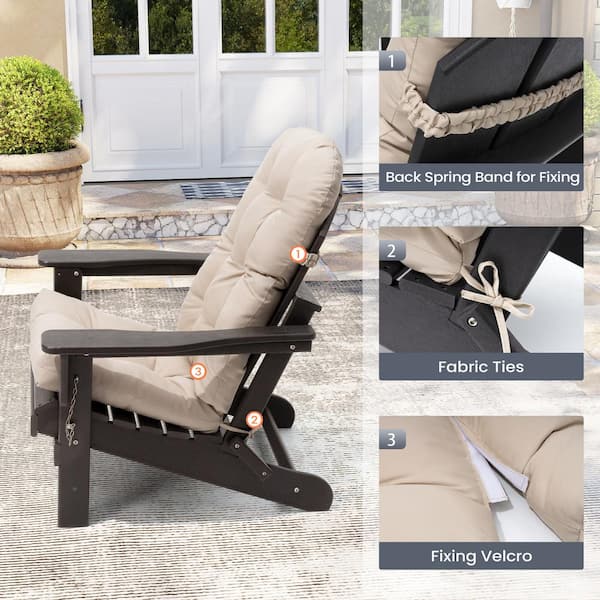Straps or a Non-Slip Bottom? How to Keep Your Custom Chair Pads in Place
Have you ever sat down for dinner, only to have your chair pad slide an inch to the left? It’s a small, daily annoyance that proves one thing: a perfect custom cushion is only perfect if it stays put.
As custom cushion specialists, we've helped hundreds of customers solve this exact problem. The solution comes down to choosing the right mounting method for your specific chair and lifestyle. Your two main options are traditional straps (like ties or Velcro) and modern non-slip bottoms.
This guide will give you a clear, expert comparison to help you decide, whether you're creating a set for your dining chairs or designing a cozy window seat cushion.

The Case for Straps (Ties & Velcro)
Straps are the classic method for physically tethering a cushion to a chair frame. They work by looping ties around the back or spindles of a chair or by using hook-and-loop Velcro strips to bond the cushion to the seat.
Why You'd Want Them (Pros):
- Absolute Security: Straps anchor the cushion, making them the best choice for high-movement situations like rocking chairs or kids' seating. The cushion stays exactly in place, no matter what.
- A Truly Custom Fit: They can be tailored to fit virtually any chair design, which is ideal for chairs with open spindles or unique shapes.
What to Watch Out For (Cons):
- They're Visible: The biggest drawback is aesthetic; the straps or Velcro tabs are often visible, which can interrupt the clean lines of a chair.
- Potential for Wear: Over time, fabric ties can fray, and the adhesive on stick-on Velcro can lose its grip, an issue commonly discussed by users online. The adhesive can also leave a residue on your chair's surface.
The Modern Choice: Non-Slip Bottoms
The non-slip bottom is an increasingly popular, modern solution that uses friction rather than fasteners to prevent sliding. It involves a high-friction material, like a rubberized mesh, that is either built into the cushion or placed underneath it. As some experts in seating and ergonomics note, the right interface between cushion and surface is key to stability.
Why They're So Popular (Pros):
-
An Invisible Solution: Because the gripper is hidden, this method offers a perfectly clean and modern aesthetic. Your
custom bench cushionslook like they are floating effortlessly in place. - Effortless to Use: Installation is instant—you just place the cushion on the chair. This makes it incredibly easy to remove for cleaning or to swap out seasonal outdoor cushions.
- Safe for Your Furniture: With no adhesives or ties, there is zero risk of damaging or leaving marks on your chair's finish.
What to Watch Out For (Cons):
- Less Secure Than Straps: While great for most daily use, a strong, deliberate slide can still shift the cushion. It relies on friction, not a physical anchor.
- Depends on the Surface: This method is most effective on smooth, hard surfaces like wood, metal, or plastic. It is less effective on seats that are already upholstered.
- They Wear Out: The gripper material can lose some of its tackiness over time and may need to be replaced to maintain its grip. Some users have found that even high-quality gripper pads for couches may need periodic refreshing.
Quick Comparison: Straps vs. Non-Slip Bottom
| Feature | Straps (Ties/Velcro) | Non-Slip Bottom |
|---|---|---|
| Security Level | Very High—anchors cushion in a fixed position. | Moderate—relies on friction. |
| Visibility | Visible ties or Velcro tabs. | Invisible when underneath cushion. |
| Ease of Installation | Time-consuming—measure, tie, adjust. | Instant—lay gripper under cushion. |
| Chair Compatibility | Universal—any chair frame. | Best on smooth, rigid surfaces. |
| Maintenance | Retie or replace worn straps/adhesive. | Replace gripper mat as it wears. |
| Risk to Chair Finish | Possible abrasion or adhesive residue. | None. |
Our Expert Recommendation: Which Should You Choose?
In our experience, the best choice depends entirely on your priorities. Before you decide, remember that the mounting method is just one piece of the puzzle. The overall performance of your cushion also depends on selecting the perfect filling for comfort and support and choosing the right fabric for durability, especially for outdoor use. Even the ideal thickness of the cushion plays a major role in its function and feel.
With that in mind, here’s how to make your choice:
Choose Straps when:
- Security is your #1 priority. This is our top recommendation for rocking chairs, gliders, and any seating used by active children.
Choose a Non-Slip Bottom when:
- Aesthetics are most important. For a clean, modern look where no hardware is visible, this is the best option.
- Your chairs have smooth, hard surfaces (wood, metal, etc.) where the gripper can be most effective.
- Convenience matters. If you frequently remove cushions for cleaning or seasonal changes, the ease of a non-slip bottom can't be beaten.
Ultimately, the decision is a balance between absolute stability and a clean, effortless look. By understanding the pros and cons, you can choose a mounting method that ensures your custom cushion is not only beautiful but perfectly functional for your home. If you're still weighing whether a brand new custom cushion might be a better choice than reupholstering, we can help you explore all the options.
